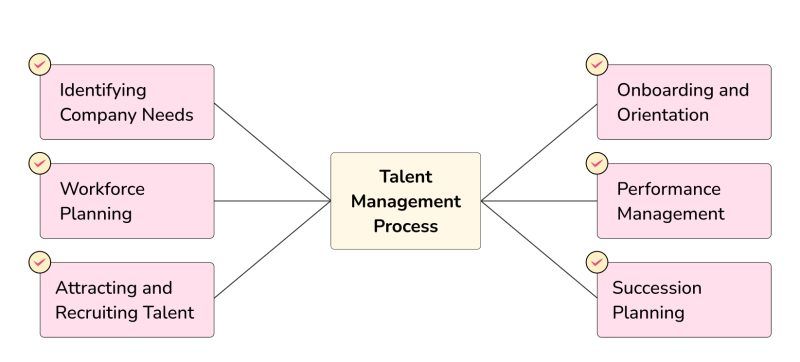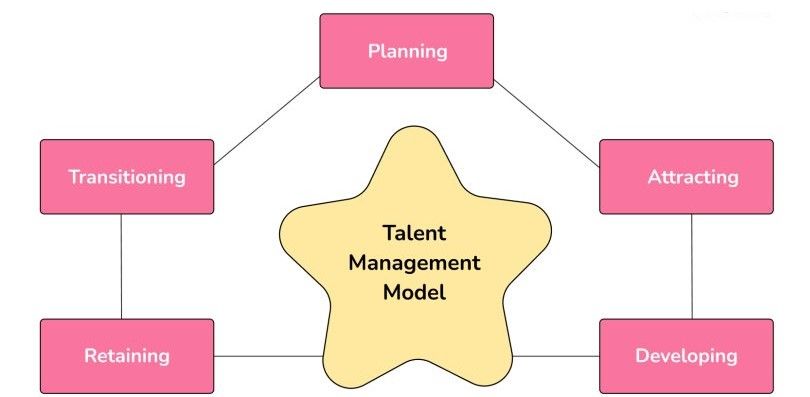Talent Management: Process, Meaning and Model
Reading Time:
Reading Time:

Talent management is an organization's commitment to recruiting, developing and retaining talented employees. It includes all processes and systems that help maintain and improve a high-performing workforce.
The goals of talent management begin with determining the need for qualified employees in the company, followed by selecting candidates with the necessary potential and skills for the desired position. Once the right employees are hired, talent management implements competitive compensation packages that can include attractive salaries, regular raises, health insurance, paid vacation, and other benefits. Training and refresher programs will be offered to selected employees to ensure they meet the evolving needs of the business.
Talent management is an important part of human resources management. It is a conscious approach to attracting, developing and retaining talented employees who have the skills and abilities necessary to achieve the company's current and future goals. The importance of talent management can be highlighted by creating and maintaining a supportive and employee-oriented organizational culture.
In other words, talent management is a company's commitment to attracting, developing and retaining the best and brightest employees. In today's competitive business landscape, it has become an essential management process.
The importance of talent management are:
⁕ Creating a high-performing workforce by attracting and retaining high-potential employees through effective training and refreshment.
⁕ Increasing organizational productivity.
⁕ Retaining talented and productive staff.
⁕ Ensuring growth and innovation within the company.
⁕ Development of employee skills and competencies
⁕ A sufficient pool of competent and talented employees can facilitate the performance process.
The organizational goal and support in focusing on issues that are truly important in the interests of the company. The overarching goal of talent management is to attract qualified and productive employees to the company.
Talent management goals
Talent management, also known as human capital management, includes the following processes.
⁕ Sourcing, recruiting and recruiting qualified employees
⁕ Management and determination of remuneration
⁕ Training and development opportunities
⁕ Performance management processes
⁕ Employee retention program
Benefits of Talent Management
⁕ Improved company productivity
⁕ Lower employee turnover and higher employee retention
⁕ Improved succession planning
⁕ Proper time management
Other benefits of talent management for companies include:
⁕ It helps assess employees' readiness to fill new positions
⁕ Assists in planning and effective use of working hours
⁕ Establishing a match between required skills and positions
Helps to understand employees' strengths and weaknesses Overall, talent management is an important investment for companies of all sizes. By investing in talent management, companies can improve performance, reduce turnover, increase employee engagement, improve succession planning and gain a competitive advantage.

The talent management process involves a comprehensive approach to sourcing, selecting and retaining the most suitable employees for a company. While the individual steps may vary depending on business goals, industry, and company size, there are core phases that are essential to any talent management process: talent acquisition, performance management, and succession planning.
The key steps of the talent management process are explained below:
Identifying company needs: Understanding company goals and the current talent pool is critical to determining the company's specific talent needs. This step involves aligning talent needs with the company's overall strategic direction.
Headcount planning: Collaborate with employees and stakeholders to assess available resources and capabilities to attract new talent. Human resource planning ensures that the company is adequately prepared to effectively recruit and integrate new employees.
Attracting and recruiting talent: Developing effective recruiting strategies and processes to attract candidates who have the necessary skills and qualifications and fit the company culture. This step includes sourcing candidates, conducting interviews, and making informed hiring decisions.
Induction and Orientation: Welcoming and integrating new employees into the company through a structured onboarding program. This process ensures a clear understanding of the company's expectations, goals and culture, laying the foundation for a successful employee journey.
Performance management: Establish a system for ongoing performance review assessment, feedback and development. Regular performance reviews help recognize employee achievements, identify areas for improvement, and align individual goals with company goals.
Succession planning: Developing a strategy to identify and develop employees with high potential for future leadership roles. Succession planning ensures there is a pipeline of capable employees who can step in to key positions when needed, mitigating the risk of talent gaps and ensuring the long-term stability of the business.

At the heart of successful talent management is a comprehensive and people-centered approach that takes the entire employee life cycle into account. The talent management model focuses on five key phases that are fundamental to nurturing and maximizing the potential of your workforce.
The first phase of our model emphasizes the critical importance of strategic planning. This is about aligning your talent management strategies with your company's goals. By identifying the key competencies, skills and positions required for success, you can effectively chart the course for attracting, developing and retaining top talent. Through comprehensive workforce planning and talent forecasting, you can proactively respond to talent gaps and ensure a solid pipeline of qualified employees to meet future needs.
In this phase, we shift our attention to attracting top talent for your company. We know that talent acquisition is about more than just filling positions - it's about finding the right fit. By developing compelling employer branding, developing targeted recruiting strategies and using various sourcing channels, we help you attract candidates who not only have the required skills, but also fit your company culture and values. Our goal is to create a seamless and positive candidate experience that drives engagement and encourages the best talent to choose your company as their professional home.
Once you have exceptional employees on board, the next step is to invest in their continued development and growth. Our talent management model places great emphasis on continuous learning and skill improvement. Through comprehensive training programs, mentoring initiatives and professional development opportunities, we empower your employees to achieve their full potential. By fostering a learning culture and providing tailored development plans, we help your employees acquire new skills, expand their knowledge and adapt to changing business needs.
Retaining top talent is crucial for every company. In this phase, we address the critical factors that contribute to employee engagement and job satisfaction. By implementing effective performance management systems, competitive compensation and benefits packages, opportunities for recognition and professional development, and promoting a positive work environment, we help you create a culture that fosters loyalty and encourages employees to remain engaged and motivated.
As the business landscape continues to evolve, organizations must be flexible and adaptable. Our talent management model recognizes the need for seamless transitions in times of change, be it organizational restructuring, succession planning or employee mobility. By implementing effective transition strategies and providing support during times of change, we ensure a smooth and successful workforce transition that minimizes disruption and maximizes productivity.
Talent management and performance management go hand in hand. The goal of performance management is to create a high-performing culture for the entire organization.
The goals of performance management in relation to talent management are:
⁕ Supporting employees to achieve above-average work standards
⁕ Assisting employees in identifying the key competencies required to perform a task efficiently
⁕ helps to understand who to reward
⁕ Assist in evaluating performance and setting goals
⁕ Highlighting employee success and failure
⁕ Helps track employee progress
⁕ Provides opportunity for self-assessment and improvement
⁕ Improves communication between management and employees
The benefits of performance management for companies, assessors and those being assessed are:
Organization : Recognize talent and help to nurture them , Helps in better planning and decision making, Enhanced employee retention
Appraiser : Offers a framework for feedback sharing, Helps in succession planning, Offers feedback on leadership and management styles
Appraisee : Helps identify strengths and weaknesses, Provides opportunity to raise issues, Helps understand the goals and objectives
Talent management best practices are a set of guidelines that companies can follow to attract, develop and retain top talent. These practices are critical to creating a high-performing workforce and achieving organizational goals.
Here are some of the best talent management practices:
Human resources (HR) plays a crucial role in the talent management process. Human Resources is responsible for developing and implementing policies and programs that support the attraction, development and retention of top talent. This includes:
In addition to these core tasks, HR also plays a role in other aspects of talent management, such as: in succession planning, performance management, compensation and social benefits.
To retain the best talent and reach the right candidate pool, companies can use IceHrm HRM software. It helps you find the right candidate according to the skills required for the job.